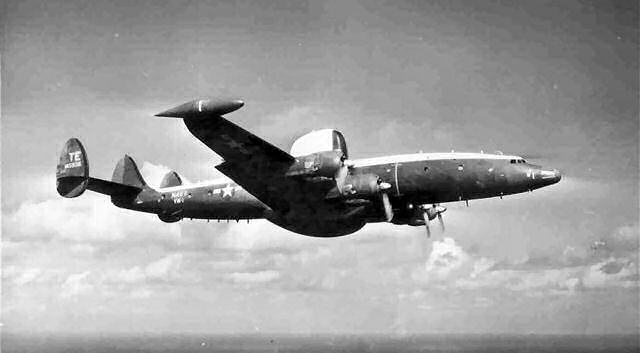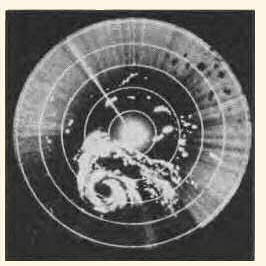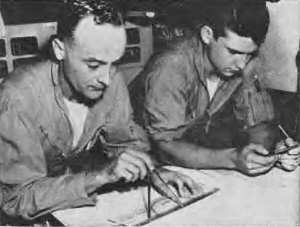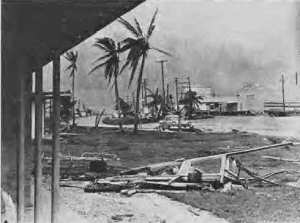 VW-1 EC-121K'S are equipped with special radar gear , can track storms at night. In 1962
the squadron located and tracked 24 typhoons, made 216 weather flights, logging some 2180 hours.
VW-1 EC-121K'S are equipped with special radar gear , can track storms at night. In 1962
the squadron located and tracked 24 typhoons, made 216 weather flights, logging some 2180 hours.
CHINESE LITERATURE calls them, quite simply, "great winds," but typhoons deserve a more awe-inspiring definition. They strike with relentless violence, leaving in their wake a swath of destruction, death and injury. As a force of nature they cannot be controlled although units like Airborne Early Warning Squadron One at NAS AGANA, GUAM, commanded by Cdr. Ralph N. Dannettell, Jr., do their professional best to prepare people for the onslaught. Last Novembers typhoon Karen demonstrated the need for VW-1 and its mission in the battle against the "great winds."
 THE 'EYE' of Typhoon Olive, an early 1963 storm, appears on the airplanes radar scope
THE 'EYE' of Typhoon Olive, an early 1963 storm, appears on the airplanes radar scope
 SENIOR weather reconnaissance officer of VW-1, LCdr. john W. Kidd and an enlisted
aerographer's mate plot data of Pacific typhoon.
SENIOR weather reconnaissance officer of VW-1, LCdr. john W. Kidd and an enlisted
aerographer's mate plot data of Pacific typhoon.
Three days prior to Karen's arrival, the Joint Typhoon Warning Center (JTWC) on Guam alerted VW-1's Typhoon Trackers, the only Navy weather air reconnaissance group in the Pacific. Immediately, Warning Star EC-121K's proceeded to the Truk-Ponape area, 500 miles southeast of the island and began plotting Karen's "eye," storm pattern, direction and speed. JTWC issued warnings.
Equipped with special radar gear capable of tracking storms at night, VW-1 flew 'round-the-clock. The flow of data indicated that Karen would be Guam's mightiest typhoon.
 TYPHOON TRACKERS hanger area was not exempt from Karen's attack. The 200-mph winds left
45,000 people on the island of Guam homeless.
TYPHOON TRACKERS hanger area was not exempt from Karen's attack. The 200-mph winds left
45,000 people on the island of Guam homeless.
Alert Condition One was set on November 11th. Island personnel readied their homes, stored loose equipment and brought supplies to typhoon-proof buildings where the would wait out the storm. VW-1 moved its planes from Guam but continued surveillance and had one aircraft high above the island to observe Karen as she struck with winds increasing from 58 to 200 mph. Later the next morning, the bulk of her fury released, Guam was left in shambles. Nine people died, hundreds were injured and damage in the amount of 200 million dollars was incurred.
Despite the devasting effect, Guam's 76,000 civilian and military personnel considered themselves lucky. VW-1's hard-working crews had accurately predicted the typhoon and her probable effects.
Officials stated that without these warning of Karen's approach an incalculable number would have perished.
